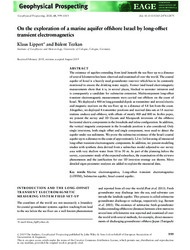On the exploration of a marine aquifer offshore Israel by long-offset transient electromagnetics
DOI: https://doi.org/10.1111/1365-2478.12875
Persistent URL: http://resolver.sub.uni-goettingen.de/purl?gldocs-11858/9245
Persistent URL: http://resolver.sub.uni-goettingen.de/purl?gldocs-11858/9245
Lippert, Klaus; Tezkan, Bülent, 2019: On the exploration of a marine aquifer offshore Israel by long-offset transient electromagnetics. In: Geophysical Prospecting, Band 68, 3: 999 - 1015, DOI: 10.1111/1365-2478.12875.
 |
Dokument öffnen: |
The existence of aquifers extending from land beneath the sea floor up to a distance of several kilometres has been observed and examined all over the world. The coastal aquifer of Israel is a heavily used groundwater reservoir which has to be constantly monitored to ensure the drinking water supply. Former land-based electromagnetic measurements show that it is, in several places, blocked to seawater intrusion and is consequently a candidate for submarine extension. Multicomponent long-offset transient electromagnetic measurements were carried out offshore on the coast of Israel. We deployed a 400-m-long grounded dipole as transmitter and several electric and magnetic receivers on the sea floor up to a distance of 4.8 km from the coast. Altogether, we deployed 8 transmitter positions and received data sets at 14 receiver stations onshore and offshore, with offsets of mostly 400 and 800 m. In this paper, we present the survey and 1D Occam and Marquardt inversions of the offshore horizontal electric components in the broadside and inline configuration. In addition, the vertical magnetic component in the broadside position is also considered. Only single inversions, both single offset and single component, were used to detect the aquifer under sea sediments. We prove the submarine existence of the Israeli coastal aquifer up to a distance to the coast of approximately 3.2 to 3.6 km using all measured long-offset transient electromagnetic components. In addition, we present modelling studies with synthetic data derived from a subsurface model adjusted to our survey area with very shallow water from 10 to 50 m. As part of the planning before the survey, a parameter study of the expected subsurface, the examination of the airwave phenomenon and the justification for our 1D inversion strategy are shown. More detailed eigen parameter analyses are added to explain the measured data.
Statistik:
ZugriffsstatistikSammlung:
Schlagworte:
Marine electromagneticsLong-offset transient electromagnetics (LOTEM)
Submarine aquifer
Israel coastal aquifer
This is an open access article under the terms of the Creative Commons Attribution License, which permits use, distribution and reproduction in any medium, provided the original work is properly cited.

